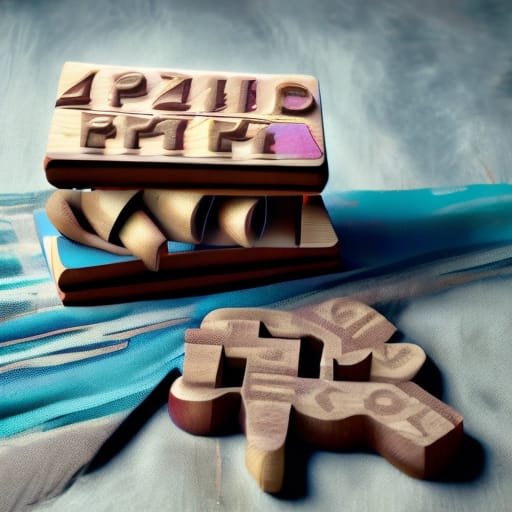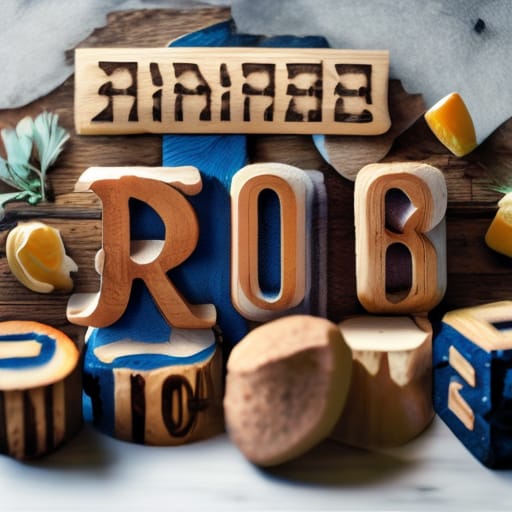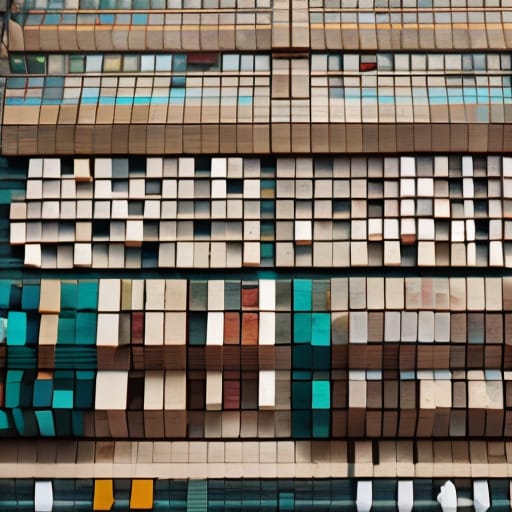Pastel wooden blocks are a timeless toy that offers a world of benefits for developing minds. With their soothing pastel colors and endless play potential, these blocks stimulate creativity, critical thinking, and a host of skill-building play activities. As beautiful as they are beneficial, pastel blocks open up new frontiers for fun and learning.
An Introduction to Pastel Wooden Blocks
Pastel wooden blocks feature soft and inviting color palettes coupled with the warmth and versatility of natural wood. These toys for toddlers and up have graced playrooms for generations.
Characteristics of pastel wooden blocks include:
- Soft, non-toxic water-based paints and stains
- Smooth sanded wood with round edges
- Vibrant and gender-neutral pastel colors
- Standard square and rectangular shapes
- Embossed patterns, letters, numbers, and images
- Range of sizes from small manipulatives to oversized building blocks
Crafted from renewable wood sources like rubberwood and beech wood, they have an unbeatable sustainability factor. Unlike plastic blocks, the tactile wood surface offers better grip and develops fine motor control.
These colorful building blocks build STEM/STEAM skills in children through construction play, shape recognition, and counting activities. Their versatility also makes them ideal Montessori toys aligned with child-centered learning approaches. Whether used in homes, classrooms, or therapy settings, pastel wooden blocks inspire creative hands-on play-based learning.
Why Pastel Wooden Blocks Matter for Early Childhood Development
More than just a toy, pastel wooden blocks offer a spectrum of developmental benefits that lay strong foundations for early learning.
Enhancing Cognitive Skills Through Play
Pastel blocks boost cognitive abilities ranging from:
- Problem-solving – By imagining and designing block structures
- Spatial intelligence – Through organizing blocks spatially
- Mathematics – Counting, sorting, patterning blocks
- Science – Testing stability, balance, gravity through towers
- Language – Storytelling, describing block creations
As an open-ended toy, children engage higher-order thinking skills to create, test, iterate and problem-solve.
Building Fine Motor Dexterity
Manipulating the blocks helps develop:
- Hand-eye coordination – Precision grasping and block placement
- Pincer grip – For holding small or thin blocks
- Manual dexterity – Moving and rotating blocks with controlled movements
The organic texture and weight of wood challenges motor skills more than plastic blocks.
Give those little hands some color therapy along with skill-strengthening play.

An In-Depth Product Review: Small Foot’s 50-Piece Pastel Wooden Block Set
Let’s review a popular pastel wooden block set perfect for Toddlers from 12 months onwards.
Key Features of the Playset
- 50 maple wood blocks in 5 bright pastel colors
- 10 geometric shapes including squares, circles, triangles, rectangles, arches
- Rounded edges and corners for safety
- Non-toxic water-based paint
- Dimensions of largest block: 5 x 2.5 x 1 inches
- Meets all ASTM safety standards
This Small Foot set offers incredible play variety in a budget-friendly package. The colors chosen have high visual contrast to stimulate developing eyes. A mix of shapes keeps spatial reasoning and construction play interesting.
With smooth finish blocks sized for small hands, it encourages endless experimentation that builds STEM foundations. As a lightweight set, toddlers can comfortably grip and move the pieces while exercising their fingers, wrists, and forearms.
Ideal Age and Safety Considerations
The founder is a Montessori teacher who designed these blocks applying Montessori principles of using natural materials to inspire the senses.
Crafted from renewable maple wood with water-based paints, this set has exceptional safety credentials. meeting CPSC, ASTM, and European EN-71 safety standards.
Made for little builders aged 12 months to 4 years, the size range suits early manipulative play skills. With adult supervision, the pieces pose no choking hazards and can provide years of creative enjoyment.
Getting Creative: Key Play and Learning Activities
For growing minds, there’s no limit to hands-on learning fun with pastel wooden blocks. Here are top ways to play:
Stacking and Balancing
Familiarize little ones with spatial relationships and gravity through block play.
Ideas include:
- Stacking towers tall then knocking them down
- Balancing blocks into pyramids or crisscross patterns
- Creating tunnels and enclosures to crawl into
As they manipulate pieces, children build concentration skills and hand-eye coordination that form readiness for later STEM studies.
Recognizing Shapes and Sorting Colors
Bright colors and geometrical forms help boost cognitive abilities.
Activities include:
- Naming and feeling the distinct shapes
- Sorting by color, size, shape encouraging focus
- Making AB and ABC patterns to introduce sequencing
- Matching colors and shapes to those in picture books. Count the sides on each shape.
Language enrichment happens when describing creations, classifications and positions – over, under, behind.
Open-ended play fosters color and shape recognition along with early Math concepts.
Harnessing The Power of Pastel Alphabet Blocks
Add a set of pastel alphabet blocks to unfold more literacy learning.
Why Alphabet Blocks Matter
- Build letter recognition and phonics
- Learn to spell names, common words
- Anchor words to block constructions
- Storytelling about block creations
Alphabets boost pre-reading skills, vocabulary and narrative abilities.
Playful Early Literacy Activities
- Form letters placing blocks in correct sequence
- Sound out phonetically spelled words
- Create stories on structures spelling out key words
- Match upper and lower-case letters by color
Let those ABC blocks pave the way to reading readiness while playing!
Using Pastel Wooden Blocks in Classrooms and Homeschooling
These vivid blocks engage minds in any learning environment.
Application in Preschool and Kindergarten Classrooms
Teachers turn to these blocks to teach:
- Math & Counting: Numerical blocks, counting quantities
- Science: Size and shape sorting, symmetry, gravity
- Language: Descriptions of structures, oral stories
- Group Collaboration: Sharing materials, team building
Portable sets allow center-based learning stations that develop school-readiness abilities.
Home Learning Benefits
- Parent-child bonding: Through cooperative play
- Learning station: Rotate educational toys including blocks at home activity centers
- Skill development: At their own pace, no pressure
Consistency aids learning. Blend solo with guided play for meaningful growth.
For a Montessori-style setup educational wooden toys can provide learning in harmony.
Choosing Your Pastel Wooden Blocks: Key Buying Considerations
While buying blocks, quality and safety should be top priorities to maximize value over years.
Key features to evaluate:
For peak play value, inspect craftsmanship, eco-friendly construction and developmental appropriateness of a given set before purchase.
While basic square blocks suffice, opt for sets with shape variety for enriched play. Mix colors neutrally or go full rainbow palette.
Benefits offered by reputable brands include:
- Ethical factories, sustainable wood
- Smooth finish, long-lasting colors
- Great customer service
- Range of sizes suiting different ages
- Diverse shapes, engraved patterns
Invest in quality for these heirloom-worthy toys to outlive passing trends.
Caring For Your Pastel Wooden Blocks: Storage and Maintenance
To enjoy those blocks across childhood, proper care is key. Follow these tips:
Keeping Your Block Sets Organized
Designate storage to avoid losing pieces.
- Label zipper pouches or storage bins
- Inventory pieces periodically
- Store on low open shelves easily accessible for kids
Orderliness nurtures responsibility and makes independent play possible.
Cleaning and Preservation
Keep surfaces pristine to retain vivid colors.
- Dust pieces with soft brush or cloth
- Spot clean marks with damp cloth, avoid wetting
- Do not immerse in water
- Reseal containers to avoid dirt buildup
Handle blocks with care yourself first before expecting the same from young kids.
Getting Crafty: DIY Pastel Wooden Block Projects
These versatile blocks can transform into custom creations through crafting.
Innovative Upcycling Ideas:
- Coasters from alphabet blocks
- Home décor accents like monograms
- Unique nightlights or lamps
- Personalized welcome signs
Repurpose written-on blocks rather than discard when outgrown.
The Psychological Impact of Pastel Colors in Children’s Play
The soothing pastel hues make playing with blocks a calming, mood-enhancing experience.
The science says it all:
- Emotional regulation: Soothes emotions, managing stress
- Harmony: Encourages cooperative play
- Creativity boost: Sparks imagination and self-expression
Bright primary colors overstimulate senses. Subtler pastels spells balance.
Craft playrooms and nurseries with this color psychology in mind.
Globally Cherished: The Timeless Tradition of Artisanal Wooden Blocks
Across cultures, wooden blocks reveal craft heritage passing traditions forward.
Historic highlights:
- 18th century: Simple alphabet blocks emerge in Europe, America
- 1800s: Friedrich Froebel invents educational Kindergarten blocks
- Early 1900s: Pastel painted blocks gain popularity
- 21st century: Artisanal manufacturers sustain heirloom quality
With universal appeal, this classic toy adapts across ages and geographies.
Today’s eco-conscious parents value sustainability winning back the materials of old. Return to heirloom quality blocks connecting past with future through play.
Building an Eco-Friendly Future: Sustainable Wooden Block Manufacturing
Seeking safe, eco-friendly toys for tiny tots? Choose heirloom-quality blocks crafted sustainably.
Hallmarks of ethical production:
- FSC-certified wood from responsible forestry
- Non-toxic stains and paints, child-safe adhesives
- Conservation in manufacturing and packaging
- Giving back initiatives
When production respects people and planet, the best toys result. Invest in purpose-driven brands to align values with play.

Ensure a Safe and Fruitful Play Experience: Parental Guidance with Pastel Blocks
Make the most of playtime avoiding pitfalls with vigilant supervision.
To foster meaningful play, remember:
- Watch play with small pieces not suitable under 3 years
- Set expectations about not throwing hard materials
- Teach sharing blocks cooperatively
- Rotate toys to sustain engagement over time
- Allow self-expression guiding gently. There’s no fixed “right way” to play.
Through caring involvement massive developmental gains happen – for both child and guardian!
User Impressions: Reviews of Pastel Wooden Block Performance
Wondering how pastel blocks fare with real tiny users? Past delighted parents and teachers share glowing feedback:
Parent review highlights:
“My twins have played daily with these blocks for over 3 years now – and they still look new!”
“Kiddo sorts the shapes and colors for hours gaining concepts naturally”
“Grandkids prefer these over plastic – they last generations”
Teacher testimonials confirm:
“A must-have material in every play-based classroom”
“The quality sets engage children across learning domains effortlessly”
“Children taught to care for materials develop mindfulness and responsibility”
Affordable, durable and wildly flexible, few toys rival the play value of trusted wooden blocks. Made well, they stand the test of vigorous play and time.
The Takeaway: Why We Recommend Pastel Wooden Blocks
At once back-to-basics and forward-thinking, pastel wooden blocks check all boxes:
- Adaptable open-ended play value
- Premium quality and safety
- Eco-friendly and ethically made
- Enriching colors and designs
- Physical and cognitive skill builder
These tested and trusted toys spark creativity that shapes young minds on the path to later success. Few investments yield such lasting payoff.
Embrace the sheer joy of learning through play – one pastel block at a time!
Conclusion
This beginner’s guide covers everything a parent or teacher needs to know about incorporating pastel wooden blocks into early education. With their versatility and eco-friendly ethos, these beautiful blocks inspire skills through play unmatched by flashier toys. Made well, they promise to delight generations if cared for properly. Add these heirloom-worthy blocks to your toy chest to set any little learner on a bright path ahead!
Frequently Asked Questions
How do I choose the best pastel wooden blocks for my child?
Focus on quality craftsmanship from sustainable sources when buying blocks. Seek smooth sanded wood with round edges for safety and vivid non-toxic paints. Aim for reputable brands that use child-safe adhesives. Consider varied shapes and sizes to enrich play.
What skills do pastel alphabet blocks develop?
Alphabet blocks boost literacy skills, encouraging letter recognition, phonics, pre-reading and spelling. Playing with alphabet blocks builds vocabulary too as children sound out words and engage in storytelling. These tools pave the way for language mastery.
How can I use pastel wooden blocks to teach toddlers colors?
Sorting colorful blocks into piles is an easy, engaging way to teach color recognition. Name each color as you hand blocks to pile up. Point out matching colors in picture books. Ask child to identify or hand you blocks of a requested hue.
Why choose wooden over plastic blocks?
Sustainably sourced wooden blocks have unbeatable eco-friendly credentials compared to plastic. Wooden blocks also have a natural tactile warmth and texture that promotes fine motor skills. Made ethically, these heirloom-quality sets far outlast cheap plastic sets.
How do I clean and store pastel wooden blocks properly?
Dust wooden pieces periodically and spot clean marks gently with a damp cloth. Avoid immersing blocks in water. Let blocks air dry completely before returning to labeled storage bins kept on low shelves for easy access. Handle with care and store properly for years of enjoyment.
